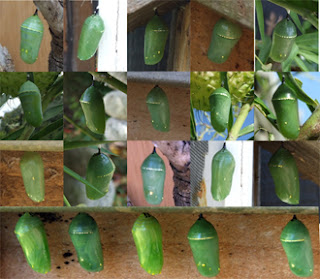While the decline of the giant panda, great apes and various cetacean species have long garnered headlines, our scale prejudice has meant invertebrates have fared rather less well. Only with the worrying spread of colony collapse disorder (CCD) in bee hives have insect-themed stories gained public attention; yet most of the millions of other small critters remain on the sidelines. I've often mentioned that overlooking these small marvels could backfire on us, considering we don't know the knock-on effect their rapid decline - and possible near-future extinction - would have on the environment we rely on.
One such example here in New Zealand is our native praying mantis Orthodera novaezealandiae, which for all we know could be a key player in the pest control of our farms and gardens. Mantid species are often near the apex of invertebrate food webs, consuming the likes of mosquitoes, moth caterpillars and cockroaches. I admit that they are not exactly discriminating and will also eat useful species such as ladybirds or decorative ones like monarch butterflies. However, they are definitely preferable to pesticides, a known cause of CCD today and an acknowledged factor of insect decline since Rachel Carson's pioneering 1962 book Silent Spring.
Of course, we shouldn't just support species due to their usefulness: giant pandas aren't being conserved for any particular practical benefit. From a moral perspective it's much easier to convince the public that we should prevent their extinction than that of the rather uncuddly mantis. We still know so little about many insect species it's difficult to work out which need to be saved in order to preserve our agribusiness (versus all the others that of course should be preserved regardless). I’m not averse to careful extermination of plagues of locusts or mosquitoes, but indiscriminate destruction due to greed or stupidity is well, stupid, really.
Down but not out: the New Zealand praying mantis Orthodera novaezealandiae
Back to O. novaezealandiae. I've only seen New Zealand's sole native mantis species three times in the 'wild': twice in my garden in the past two years and once in my local reserve before that. What is particularly interesting is that since initial descriptions in the 1870's, hypotheses regarding its origin appear to have evolved due to patriotic trends as much as to factual evidence. Late Nineteenth Century accounts of its spread suggest an accidental importation from Australia by European sailing ship, since it is a clumsy, short-range flier and seabirds are unlikely to carry the insects - and certainly not their cemented oothecae (egg sacks) - on their feet.
However, some Victorian naturalists thought the insect was incorporated into Maori tradition, implying a precolonial existence. In contrast, A.W.B.Powell's 1947 book Native Animals of New Zealand refers to the native mantis as Orthodera ministralis (which today is only used to describe the Australian green mantis) and the author states it may well be a recent arrival from across the Tasman Sea. So the native species may not be particularly native after all! I find this fascinating, insomuch as it shows how little we understand about our local, smaller scale, wildlife when compared to New Zealand's birds, bats and even reptiles.
The specimens in my garden have lived up to their reputation for being feisty: they seem to size you up before launching themselves directly towards you, only for their wings to rapidly falter and force the insect into an emergency landing. After the most recent observation, I looked around the outside of the house and found three oothecae, two of which were under a window sill built in 2016. These finds are cheering, as it means that at least in my neighbourhood they must be holding their own.
Perhaps their chief enemy these days is the invasive Miomantis caffra. This inadvertently-introduced South African mantis was first seen in 1978 and is rapidly spreading throughout New Zealand's North Island. The intruder - frequently spotted in my garden - has several advantages over O. novaezealandiae: firstly, it is able to survive through winter. Second, it produces rather more nymphs per ootheca; combined with hatching over a longer period this presumably leads to a larger numbers of survivors per year. In addition, and most unfortunately, the native male appears to find the (cannibalistic) South African female more attractive than the female of its own species, frequently resulting in its own demise during mating.
Humans too have further aided the decline of the native mantis with the accidental introduction of parasitic wasps and widespread use of pesticides. After less than a century and a half of concerted effort, European settlers have managed to convert a large proportion of the best land in this corner of the Pacific into a facsimile of the English countryside - but at what cost to the local fauna and flora?
Working to the old adage that we won't save what we don't love and cannot love what we don't know, perhaps what is really required is an education piece disguised as entertainment. Promoting mammals in anthropomorphic form has long been a near-monopoly of children's literature (think Wind in the Willows) but perhaps it is about time that invertebrates had greater public exposure too. Gerald Durrell's 1956 semi-autobiographical best-seller My Family and Other Animals includes an hilarious battle in the author's childhood bedroom between Cicely the praying mantis and the slightly smaller Geronimo the gecko, with the lizard only winning after dropping its tail and receiving other injuries. Perhaps a contemporary writer telling tales in a similar vein might inspire more love for these overlooked critters before it is too late. Any takers?









